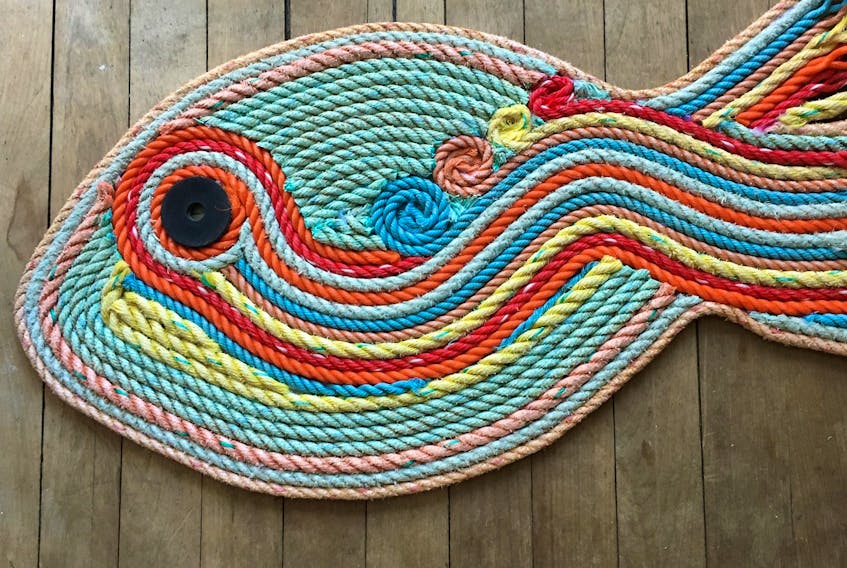The arrival of 2020 saw Nicole Poirier enter her third year of making baskets, mats, and other decor items out of reclaimed fishing rope. It’s an art form she’s taught herself, which she creates in her spare time.
Poirier makes these reclaimed rope products with her good friend Tanya Holt. They grew up together in Cheticamp, Nova Scotia before finding themselves both in Halifax. They were running partners originally, but found it hard to get out in the winter. They wanted to figure out something that they could continue to do together and came up with this craft.
“Being on the Cabot Trail, being from Cheticamp, you’re at the ocean all the time, at the beach,” says Poirier. “It was like it was calling us, I’m going to say.”
‘Truckloads of rope’
The duo sells their wares under the fitting name of Art Marée Haute. Marée Haute means ‘at high tide’ in French.

“My brother’s a fisherman in Cape Breton,” says Poirier. “There are whales being caught in all the netting and rope. Some of the stuff out there is not just gear that was set out, it’s extra rope, that’s just thrown overboard. There was an abundance of rope being put to the landfill as well,” says Poirier.
“Truckloads of rope.”
It’s this very rope she works with.
“My brother is kind of like the scout down in Cape Breton. And I have lots of friends down there.”
Poirier says people will call her mother, who still lives in Cheticamp, or message her saying they have rope for her.
“I say, ‘bring it to mom’s and throw it in the shed.’ I’m very lucky, I have friends that come up that have trucks and they’ll bring it to me.”
She and her friends will intercept loads of rope headed for the dump in the back of pick-up trucks they see on the roads.
“I know that our little portion of rope that we save from the landfill is very teeny tiny, but at least we’re saving that,” she says.
“It’s mostly rope from Cape Breton. We’ve had rope from Peggy’s Cove as well, and out by QuarterDeck. We do our little part. It’s amazing how much of that stuff is just being thrown out.”
On all their notes, they write, “The whales will thank you.’”

‘Calming and soothing’
Poirier and Holt learned their craft off YouTube tutorials. Holt’s husband makes the jigs they need to use as a template to make their creations. They started with mats and turned to Pinterest for inspiration, which led them to making baskets as well. Now they create lobster and fish mats (their most popular items), wine, baskets, Christmas trees, Celtic knots, wreaths, runners, and trivets, to name a few products.
Poirier says working with the reclaimed rope is not a fast process, but not slow either. A floor mat will take her 40 minutes to make. She’ll create three or four lobster or fish mats in a day.
“I do this usually every Saturday and sometimes Sundays too, depending if I have orders to fill. But I would do it every day if I could,” she says.
“You’re creating with this rope, it’s calming. You’re working by yourself, you’re trying to match colours. The creating process is kind of calming and soothing.”
By contrast, during the week, Poirier spends her days surrounded by children, taking care of two- and three-year-olds in the toddler room at University Children’s Centre on the Dalhousie Campus in Halifax. She’s been working there for 30 years and has been an Early Childhood Educator for nearly 40 years.
“I’m happy with the way that it’s going but of course I would love 100 per cent to be able to do this every day,” she says. “My dream would be to move back to Cape Breton and be able to have a little shop down there and set up and do it as the people are coming through, so they can see how it’s being done.”

Special creations
The reclaimed rope studio used to operate out of Holt’s home by Peggy’s Cove. Holt is currently away teaching in Abu Dhabi. For now, Poirier is working solo. She’s moved all the supplies to her house.
“My house is teeny tiny,” she says. “I’ve made my little sunroom at the front my workroom.”
The items are available for sale on the Art Maree Haute Facebook page. They have items available for sale at the Sunset Art Gallery and Les Trois Pignons in Cheticamp. The Quarterdeck Beachside Villas in Summerville also has pieces in its gift shop, and The Social Boutique in Bedford carries stock as well. Poirier says most interest comes through word of mouth.
“People call for orders and request colours,” she says. “We have to tell them, actually, the colour we have right now is the colour we just got. Whatever the fisherman buy, and then get rid of, that’s what we work with.”
As luck would have it, white, red, and blue are fairly common fishing rope colours, and Poirier crafts lots of items like Celtic knots, Christmas trees and lobsters in Acadian colours, a nod to her heritage.
“Sometimes, you still get the salt smell of the ocean in the rope. Sometimes, some of it has seaweed through it.”
Poirier says she tries to invent new things to make, to spike interest. A custom order of a horse’s head is now a popular item. Once, they weaved a cat.
When design stars and television hosts Colin McAllister and Justin Ryan were in town, they snapped a picture posing with one of her lobster mats, which she thought was “pretty cool.”
Sometimes, the reclaimed rope creations are a bit more sentimental.
“Our parents are getting older and a lot of our friends’ parents are older, or dying, and a lot of our dads were fishermen, so I tell them, find some rope and we can make something special for you,” says Poirier.
“We’ve found rope from my dad (who was also a fisherman), so I made a basket and some Christmas trees with them. Same with some of the rope my brother had that I knew was specifically his. I made stuff with it and I gave it to my brother and his wife, and my mom has a set from Dad’s rope. It’s cool when you can have something made from your parent’s stuff.”
She also has friends whose dog had lobster rope as his leash. When they had to put their dog down, she made something special with that rope.
Everyone, including the whales, will thank her.









